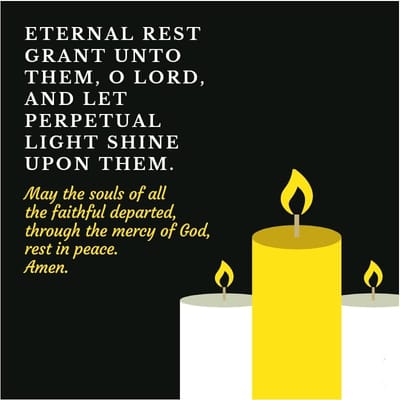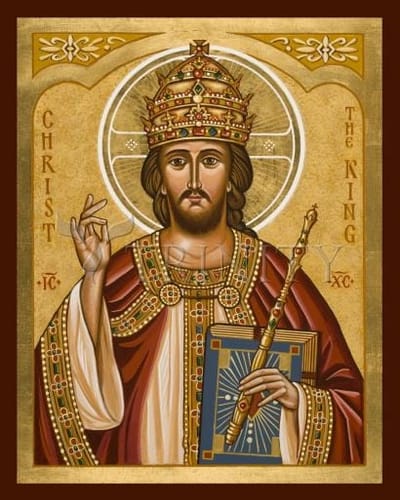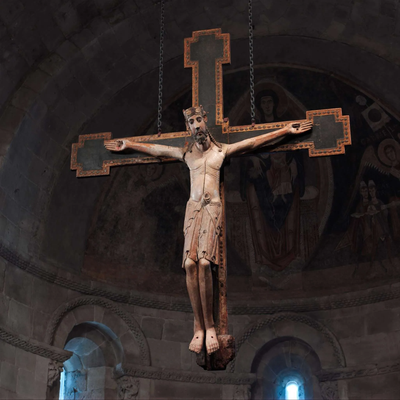About Today



Sunday 23 November 2025
Christ the King Solemnity
Jesus Christ is the King of kings: come, let us adore him.
Year: C(I). Liturgical Colour: White.
Christ the King
The Solemnity of Our Lord Jesus Christ, King of the Universe was instituted by Pope Pius XI in 1925, the sixteenth centenary of the Council of Nicaea at which the doctrine of the consubstantiality of Christ with the Father was defined. Its eschatological character was confirmed by its move, in the calendar reforms of the Second Vatican Council, to the final Sunday of the liturgical year.
The Pope asserted that the most effective defence against the destructive forces of the age is the recognition of the kingship of Christ; and, furthermore, a feast which is celebrated every year by everyone is a far better way of deploying that defence than any number of books written by learned people. First, we do; then we come to understand what it is that we are doing.
Each of us has been anointed with holy oil at baptism, as priest, prophet and king. The feast of Christ the King is thus a good moment to reflect on our kingship and on what “king” means and how to be one. Understanding the feast makes us understand our own call better.
One possible point of entry is in Genesis, where Adam sits in state and God brings him all the animals for him to give them names. To give names to one’s subjects is the act of a king. The responsibility of a king is then to care for his subjects, which is why we are obliged to act as custodians of creation: something no other creature is. How far that responsibility takes one can then be seen in the King of the Universe, who is simultaneously the ruler of all and the servant of all. He rules in triumph; and he rules from the Cross.
Perhaps a way into a meditation on all this would be to ask, “Over whom am I, personally, king?” and hence “Whom am I called to serve?”
In other years: Pope St Clement I
Clement was Bishop of Rome after Peter, Linus and Cletus. He lived towards the end of the first century, but nothing is known for certain about his life. Clement’s letter to the Corinthian church has survived. It is the first known Patristic document, and exhorts them to peace and brotherly harmony.
In other years: Saint Columbanus, Abbot (540? - 615)
He was born in Ireland before the middle of the sixth century. He was a monk from his youth and was learned in both sacred and secular literature. At the age of 45 he left Ireland and went to Europe, where he founded three monasteries in what is now France. His monastic rule was strict, based on Irish practice.
King Thierry II of Burgundy had a veneration for Columbanus and often visited him. Columbanus’s criticisms of Thierry’s debauched living and practice of concubinage enraged the king’s grandmother Brunhild, and eventually Columbanus and all other Irish-born monks were ordered to be deported to Ireland. They eluded their captors, and after an unsuccessful attempt to evangelize the pagan tribes near modern-day Zürich they reached Italy, where Columbanus founded the monastery at Bobbio. He died there in 615.
The Rule of St Columbanus was eventually superseded by the milder Rule of St Benedict. Columbanus’s writings are among the earliest evidence of Irish knowledge of Latin. Some of what he wrote related to ecclesiastical controversies of the time and is no longer read, but several extracts from his “Instructions” are still part of the Office of Readings. His style combines an underlying passion with a strong and rhythmic rhetorical structure.
Other saints: Blessed Miguel Agustín Pro (1891 - 1927)
United States
Solemnity of Christ the King
Gospel: Luke 23:35-43
At that time: The rulers scoffed at Jesus, saying, ‘He saved others; let him save himself, if he is the Christ of God, his Chosen One!’ The soldiers also mocked him, coming up and offering him sour wine and saying, ‘If you are the King of the Jews, save yourself!’ There was also an inscription over him, ‘This is the King of the Jews.’
One of the criminals who were hanged there railed at Jesus, saying, ‘Are you not the Christ? Save yourself and us!’ But the other rebuked him, saying, ‘Do you not fear God, since you are under the same sentence of condemnation? And we indeed justly, for we are receiving the due reward of our deeds; but this man has done nothing wrong.’ And he said, ‘Jesus, remember me when you come into your kingdom.’ And he said to him, ‘Truly, I say to you, today you will be with me in paradise.’
Reflection on the Carved Wood Crucifix
Christus vincit! Christus regnat! Christus imperat!
Christ conquers! Christ rules! Christ reigns!
Today we celebrate the Feast of Christ the King. The Church's liturgical year concludes with today's feast, which was instituted by Pope Pius XI in 1925 to celebrate the Jubilee Year and the 16th centenary of the Council of Nicaea.
Today we celebrate that Christ is king in the kingdom in which we already live. Here is a beautiful explanation given by Gerald Darring (St Louis University, Center for Liturgy):
‘The Kingdom of God is a space. It exists in every home where parents and children love each other. It exists in every region and country that cares for its weak and vulnerable. It exists in every parish that reaches out to the needy.
The Kingdom of God is a time. It happens whenever someone feeds a hungry person, or shelters a homeless person, or shows care to a neglected person. It happens whenever we overturn an unjust law, or correct an injustice, or avert a war. It happens whenever people join in the struggle to overcome poverty, to erase ignorance, to pass on the Faith.
The Kingdom of God is in the past (in the life and work of Jesus of Nazareth);
it is in the present (in the work of the Church and in the efforts of many others to create a world of goodness and justice);
it is in the future (reaching its completion in the age to come).
The Kingdom of God is a condition. Its symptoms are love, justice, and peace…'
Our artwork is a 12th century large sanctuary crucifix, depicting Christ the King hanging on the cross. When artists of the early Middle Ages depicted Christ on the Cross, they often showed Him not as a suffering victim but as a triumphant Saviour. In such portrayals, Jesus stands upright and composed, His body unbowed by pain, His head held high and serene. Far from diminishing the reality of the Crucifixion, this artistic choice proclaimed a deeper truth: that Christ had conquered death. His calm, living presence on the Cross looked beyond the agony of Calvary toward the glory of the Resurrection. For this reason, the crown of thorns was often replaced with a jeweled crown, the symbol of a victorious king.
In this Romanesque example, the head of Chris leans slightly forward, almost as if to acknowledge the viewer. Carved nearly life-size and fully in the round, the sculpture was designed to be seen from every side, its detailed back suggesting it once hung suspended between the sanctuary and the nave.n this Romanesque example, the head of Chris leans slightly forward, almost as if to acknowledge the viewer. Carved nearly life-size and fully in the round, the sculpture was designed to be seen from every side, its detailed back suggesting it once hung suspended between the sanctuary and the nave.
Crucifix, with corpus featuring Christ the King,
Made in Castile-León, Spain,
Sculpted 1150–1200,
White oak with paint, gold leaf, and tin leaf (corpus); softwood with paint and tin leaf (cross)
© Metropolitan Museum New York
Christ the King Solemnity
Jesus Christ is the King of kings: come, let us adore him.
Year: C(I). Liturgical Colour: White.
Christ the King
The Solemnity of Our Lord Jesus Christ, King of the Universe was instituted by Pope Pius XI in 1925, the sixteenth centenary of the Council of Nicaea at which the doctrine of the consubstantiality of Christ with the Father was defined. Its eschatological character was confirmed by its move, in the calendar reforms of the Second Vatican Council, to the final Sunday of the liturgical year.
The Pope asserted that the most effective defence against the destructive forces of the age is the recognition of the kingship of Christ; and, furthermore, a feast which is celebrated every year by everyone is a far better way of deploying that defence than any number of books written by learned people. First, we do; then we come to understand what it is that we are doing.
Each of us has been anointed with holy oil at baptism, as priest, prophet and king. The feast of Christ the King is thus a good moment to reflect on our kingship and on what “king” means and how to be one. Understanding the feast makes us understand our own call better.
One possible point of entry is in Genesis, where Adam sits in state and God brings him all the animals for him to give them names. To give names to one’s subjects is the act of a king. The responsibility of a king is then to care for his subjects, which is why we are obliged to act as custodians of creation: something no other creature is. How far that responsibility takes one can then be seen in the King of the Universe, who is simultaneously the ruler of all and the servant of all. He rules in triumph; and he rules from the Cross.
Perhaps a way into a meditation on all this would be to ask, “Over whom am I, personally, king?” and hence “Whom am I called to serve?”
In other years: Pope St Clement I
Clement was Bishop of Rome after Peter, Linus and Cletus. He lived towards the end of the first century, but nothing is known for certain about his life. Clement’s letter to the Corinthian church has survived. It is the first known Patristic document, and exhorts them to peace and brotherly harmony.
In other years: Saint Columbanus, Abbot (540? - 615)
He was born in Ireland before the middle of the sixth century. He was a monk from his youth and was learned in both sacred and secular literature. At the age of 45 he left Ireland and went to Europe, where he founded three monasteries in what is now France. His monastic rule was strict, based on Irish practice.
King Thierry II of Burgundy had a veneration for Columbanus and often visited him. Columbanus’s criticisms of Thierry’s debauched living and practice of concubinage enraged the king’s grandmother Brunhild, and eventually Columbanus and all other Irish-born monks were ordered to be deported to Ireland. They eluded their captors, and after an unsuccessful attempt to evangelize the pagan tribes near modern-day Zürich they reached Italy, where Columbanus founded the monastery at Bobbio. He died there in 615.
The Rule of St Columbanus was eventually superseded by the milder Rule of St Benedict. Columbanus’s writings are among the earliest evidence of Irish knowledge of Latin. Some of what he wrote related to ecclesiastical controversies of the time and is no longer read, but several extracts from his “Instructions” are still part of the Office of Readings. His style combines an underlying passion with a strong and rhythmic rhetorical structure.
Other saints: Blessed Miguel Agustín Pro (1891 - 1927)
United States
Solemnity of Christ the King
Gospel: Luke 23:35-43
At that time: The rulers scoffed at Jesus, saying, ‘He saved others; let him save himself, if he is the Christ of God, his Chosen One!’ The soldiers also mocked him, coming up and offering him sour wine and saying, ‘If you are the King of the Jews, save yourself!’ There was also an inscription over him, ‘This is the King of the Jews.’
One of the criminals who were hanged there railed at Jesus, saying, ‘Are you not the Christ? Save yourself and us!’ But the other rebuked him, saying, ‘Do you not fear God, since you are under the same sentence of condemnation? And we indeed justly, for we are receiving the due reward of our deeds; but this man has done nothing wrong.’ And he said, ‘Jesus, remember me when you come into your kingdom.’ And he said to him, ‘Truly, I say to you, today you will be with me in paradise.’
Reflection on the Carved Wood Crucifix
Christus vincit! Christus regnat! Christus imperat!
Christ conquers! Christ rules! Christ reigns!
Today we celebrate the Feast of Christ the King. The Church's liturgical year concludes with today's feast, which was instituted by Pope Pius XI in 1925 to celebrate the Jubilee Year and the 16th centenary of the Council of Nicaea.
Today we celebrate that Christ is king in the kingdom in which we already live. Here is a beautiful explanation given by Gerald Darring (St Louis University, Center for Liturgy):
‘The Kingdom of God is a space. It exists in every home where parents and children love each other. It exists in every region and country that cares for its weak and vulnerable. It exists in every parish that reaches out to the needy.
The Kingdom of God is a time. It happens whenever someone feeds a hungry person, or shelters a homeless person, or shows care to a neglected person. It happens whenever we overturn an unjust law, or correct an injustice, or avert a war. It happens whenever people join in the struggle to overcome poverty, to erase ignorance, to pass on the Faith.
The Kingdom of God is in the past (in the life and work of Jesus of Nazareth);
it is in the present (in the work of the Church and in the efforts of many others to create a world of goodness and justice);
it is in the future (reaching its completion in the age to come).
The Kingdom of God is a condition. Its symptoms are love, justice, and peace…'
Our artwork is a 12th century large sanctuary crucifix, depicting Christ the King hanging on the cross. When artists of the early Middle Ages depicted Christ on the Cross, they often showed Him not as a suffering victim but as a triumphant Saviour. In such portrayals, Jesus stands upright and composed, His body unbowed by pain, His head held high and serene. Far from diminishing the reality of the Crucifixion, this artistic choice proclaimed a deeper truth: that Christ had conquered death. His calm, living presence on the Cross looked beyond the agony of Calvary toward the glory of the Resurrection. For this reason, the crown of thorns was often replaced with a jeweled crown, the symbol of a victorious king.
In this Romanesque example, the head of Chris leans slightly forward, almost as if to acknowledge the viewer. Carved nearly life-size and fully in the round, the sculpture was designed to be seen from every side, its detailed back suggesting it once hung suspended between the sanctuary and the nave.n this Romanesque example, the head of Chris leans slightly forward, almost as if to acknowledge the viewer. Carved nearly life-size and fully in the round, the sculpture was designed to be seen from every side, its detailed back suggesting it once hung suspended between the sanctuary and the nave.
Crucifix, with corpus featuring Christ the King,
Made in Castile-León, Spain,
Sculpted 1150–1200,
White oak with paint, gold leaf, and tin leaf (corpus); softwood with paint and tin leaf (cross)
© Metropolitan Museum New York